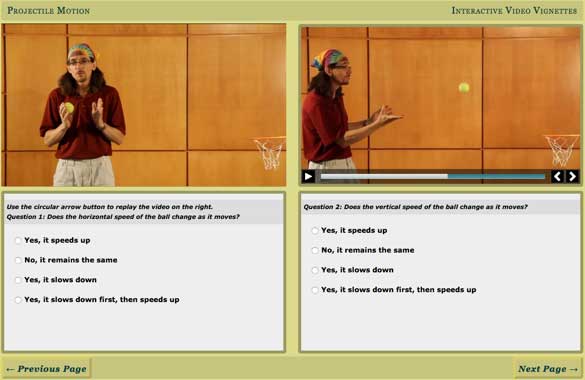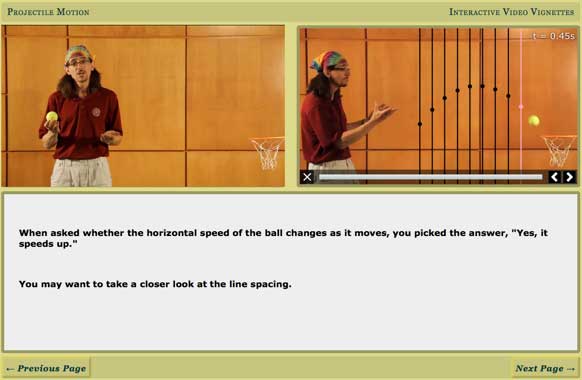Interactive Video Vignettes
Robert Teese, Rochester Institute of Technology
Priscilla Laws, Dickinson College
Kathy Koenig, University of Cincinnati
One of the common threads of Physics Education Research (PER) is that the educational process must be active rather than passive.1 Video lectures, which have become more common in recent years to support online textbooks and "flipped" classrooms, are passive experiences.2 An Interactive Video Vignette (IVV) addresses these concerns. It is a web application that combines video with interactive elements such as video analysis, graphing, multiple-choice questions, and question-based branching. The structure includes a series of video segments that are interspersed with questions and other activity-based screens. A typical simple vignette might consist of an introductory video, some type of measurement and analysis, and a wrap-up video to conclude the lesson. A more complicated one might include several experiments or demonstrations with discussions of the theory.
This new genre of online teaching materials was created in the LivePhoto Physics project. It is being developed by a collaboration between Dickinson College, Rochester Institute of Technology and the University of Cincinnati. For the past five years, faculty and students at those institutions have been writing software, making videos and testing the resulting IVVs in physics classes. At the project website (http://www.compadre.org/IVV) physics teachers can learn more about the project, get sample IVVs, and download software for making their own.
The vignette on projectile motion is a good example of a typical IVV. It is narrowly focused on the independence of horizontal and vertical motion. Although it is a simple concept, it is one that frequently confuses students. This vignette takes students five to seven minutes to complete.

Fig. 1. Two multiple-choice prediction questions in the Projectile Motion vignette.

Fig. 2. Results of video analysis (top right), showing the student’s prediction (bottom).
In the introduction of this IVV, the narrator discusses some basic aspects of projectile motion. The discussion is illustrated with a dramatic shot of a person being thrown high into the air and landing in a lake. At the end of the introductory video, the narrator tosses a ball into a basket. Students are able to replay the tossing of the ball into the basket as many times as they want (Fig. 1). Meanwhile, the narrator asks the student to watch the tossed ball and focus on the horizontal motion separately from the vertical motion. Before moving on, the student must answer two multiple-choice questions about the horizontal and vertical motion of the tossed ball (is it speeding up, slowing down, etc.).
In the next segment, the horizontal motion of the ball is investigated using video analysis. Students click on the center of the tossed ball to mark the position of the ball in each frame of the video. After each click, the horizontal position of the ball is marked with a vertical line (Fig. 2). The narrator asks the student to deduce something about the horizontal motion of the ball. On the next page, the video analysis results are shown along with the prediction the student made earlier. The narrator explains that since the time between video frames is constant, the equal spacing of the lines means the ball moved in the horizontal direction with a constant speed. In the next segment, the process is repeated, with the student creating horizontal lines for the vertical motion and seeing that the ball slows down going upward and then speeds up going downward.
The development project is research-based. The IVVs are designed based on research-validated curricular frameworks (such as Elicit-Confront-Resolve)3 as well as research on student misconceptions.4 Controlled studies are taking place at the University of Cincinnati to gauge the impact of IVVs on student learning in physics. We have collected IVV pre-post-performance data on well over 3000 students of 17 faculty. For example, a controlled study conducted in Spring 2014 involved faculty teaching the calculus-based courses at the University of Cincinnati.5 Each instructor taught two sections using similar teaching approaches and materials. In one section, each instructor assigned four IVVs (projectile motion and Newton’s Laws), while ordinary homework was assigned in their other section. The students were pre- and post-tested the first and last week of the course using the FCI6 and five additional questions written for our research. For questions involving projectile motion, the pre-test scores for the treatment (229 students) and control (157 students) groups were similar. On the post-test, however, 91% of students in the treatment group but only 79% in the control group indicated that the horizontal speed of a projectile is constant. The pre-to-posttest normalized gains were 67% and 33%, respectively. Both groups performed similarly on the post-test question involving vertical speed, but this was expected due to how the topic was covered in class.
Newton’s First and Second Law IVVs also impacted student learning. For example, when asked on the post-test what happens to the speed of a puck on ice after being kicked, 86% (55% gain) of students in the treatment group and 81% (34% gain) of students in the control group indicated that the speed remains constant. Similarly, given a constant applied force, 63% (33% gain) of students in the treatment group and 47% (23% gain) of students in the control group indicated that the speed continuously increases at a constant rate.
Studies across nine semesters have been conducted at the University of Cincinnati in both algebra- and calculus-based physics courses. The results of the different studies are confounded, as expected, by the teaching practices and assignments of each instructor and therefore cannot be merged. However, when confounding factors are taken into account on an individual instructor and pre/post-question basis, the results are consistent with those described above.
Vignettes are implemented using HTML5, so they run on tablets as well as laptop or desktop computers. Vignette Studio, a free, easy-to-use Java application being created by the project, allows instructors to make their own vignettes. Using its drag-and-drop interface, a developer moves pages into place on a workspace. Individual elements, such as images, videos, questions, video-analysis modules, graphs and so on can be dragged into place on each page. The user’s input on one page can be echoed back on a different page, allowing users to compare their predictions to the results of experiments. Question-based branching can be set up, so that each answer to a multiple-choice question links to a different subsequent page. In this way vignettes can provide remediation that is specific to the user’s needs. Additional software capabilities are planned for implementation in the remaining years of the project. The software and user manual can be downloaded from our ComPADRE website (http://www.compadre.org/IVV/studio.cfm).
The project team has created a set of sample vignettes that illustrate various styles and teaching techniques. In addition to examples of using a single narrator (as in the Projectile Motion vignette) or person-on-the-street interviews (as in the Newton’s Third Law vignette), the ComPADRE website has IVVs with an instructor interacting with one or more students, an instructor engaging in Socratic dialog with a group of students, and two instructors talking to each other. The topics covered include Newton’s Laws, circular motion, conservation laws in an inelastic collision, and electrostatics. The goal of making these samples is to help other people develop script ideas by creating and testing a collection that illustrates various ways of making vignettes.
There are also two related projects. First, at Bethel University, Keith Stein, Chad Hoyt and Nathan Lindquist are making pre-lab activities for use in advanced physics lab courses. The topic areas include fluid mechanics, AMO (atomic, molecular, and optical) physics, plasmonics, and nano-optics. These researchers are using Vignette Studio to make the activities, and are helping to enhance the IVV software with the inclusion of new capabilities. For example, in one IVV students analyze high-speed and shadowgraph videos of a ping-pong cannon to study supersonic flow and shock waves. Second, a team at RIT and Alfred University is authoring a set of interactive modules for introductory biology courses. The online priming activity in each module is an IVV. So far, vignettes on osmosis, acid/base buffers, natural selection, fermentation, genetics, scientific graphing, and photosynthesis have been finished and are being tested in biology courses.
Cengage Learning has adopted Interactive Video Vignettes for use in WebAssign homework to accompany their physics textbooks. The project members will continue working with online homework providers, textbook publishers and physics-related websites to create opportunities for instructors to use research-based IVVs.
Robert Teese is a Professor of Physics at Rochester Institute of Technology. He led the LivePhoto Physics Project.
Priscilla Laws is a Research Professor at Dickinson College. She invented Workshop Physics, co-authored Understanding Physics, and won the Robert A. Millikan Medal.
Kathleen Koenig is an Associate Professor for the Department of Physics at the University of Cincinnati. Her primary research efforts focus on undergraduate student learning and retention in the STEM majors.
(Endnotes)
1 L. C. McDermott and E. F. Redish, "Resource Letter: PER-1: Physics Education Research," Am. J. Phys. 67 (9), 755–767 (1999).
2 D. Riendeau, "Flipping the Classroom," Phys. Teach. 50, 507 (2012).
3 L. C. McDermott. "Millikan Lecture 1990: What we teach and what is learned — Closing the gap," Am. J. Phys. 59, 301-315 (1991).
4 R.K. Thornton and D.R. Sokoloff, "Assessing student learning of Newton’s laws: The Force and Motion Conceptual Evaluation and the Evaluation of Active Learning Laboratory and Lecture curricula," Am. J. Phys. 66 (4), 338-352 (1998).
5 R. B. Teese, P. W. Laws and K. Koenig, "Interactive Video Vignettes," Proceedings of the 20th International Conference on Multimedia in Physics Teaching and Learning (Ludwig Maximilians University, Munich, in press).
6 D. Hestenes, M. Wells, and G. Swackhamer, "Force Concept Inventory," Phys. Teach. 30, 141–158 (March 1992).
Disclaimer – The articles and opinion pieces found in this issue of the APS Forum on Education Newsletter are not peer refereed and represent solely the views of the authors and not necessarily the views of the APS.
